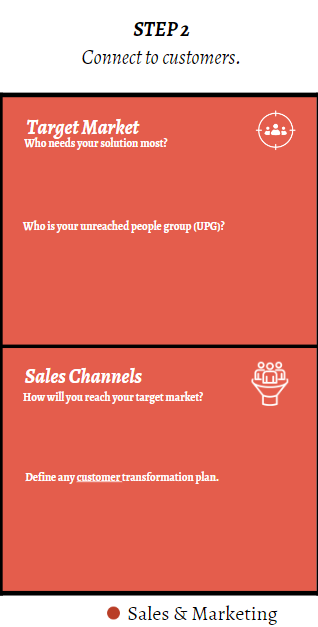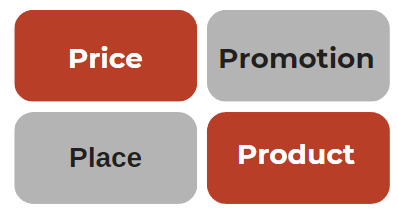Read Part 1 of The B4T Canvas Here
Step 2: Connect to Customers
Now that you have an idea that solves a problem and an initial transformation plan for your B4T, the next step is to determine how you will connect with your customers. We are going to draw on two foundational principles for sales and marketing that will determine the rest of your strategy in this section: Target Market, and Sales Channels.

It’s worth noting here that many companies describe the process of customer acquisition with a sales funnel, and gospel-centric businesses also have a funnel. Jesus described it with the parable of the sower. There are many different people who will respond in various ways to the gospel. The seeds of Good News may fall on good soil or bad, and the Holy Spirit does His work. In a similar way, different people will respond differently to your business. You cannot please everyone, and you shouldn’t! The question is: Who is your target audience, and how are you going to ensure they keep coming back? (Who is the Father drawing to Himself, this is the good soil or target market, and how are we going to disciple them to maturity.)
Target Market. Arguably, a B4T has probably already determined its target market before even beginning step 1. You are probably focused on reaching a particular people group already. However, there are many cases where the UPG that a business is spiritually engaged with is not also its customer segment. It is great if they are one and the same, but they don’t have to be. You may employ people that are unreached with the gospel, whereas your customers are back in your home country that is primarily reached. You may employ and sell to people who are mildly reached, whereas your company engages with a UPG through a poverty alleviation and other, more philanthropic means.
Moreover, even if your spiritual and customer target market are one and the same, simply listing the UPG will not be sufficient for this section. If I want to reach Somalis in Kenya, that is certainly a target market, but a storefront, marketing materials, sales techniques, even a website should all be catered to a specific market segment with unique interests, socioeconomic data, demographics such as age, gender, etc.
Let’s say you’re building a coffee shop. Before you can even begin determining the roasting profile of coffee beans, you need to determine the demographics you are targeting. If they are older, they will likely prefer dark roast coffee. If you’d like to target younger folks, you will probably need a lighter to medium roast (or several profiles). Is the bulk of your market wealthy or not? Are they male or female? Do they like flowers or not? What kind of music do they like? What subreddits do they read? What color do they wear when its raining in the spring time… Okay, that might be a bit too specific, but pretty much.
Imagine you walk into a hotel and the architecture is everything you ever dreamed of. The receptionist lets you select the floor and direction of your room and asks you a few questions about your preferences before you head to the adjoining restaurant. When you get to your room, there’s a note on your pillow that it has been selected to fit your liking. Your favorite tea begins brewing automatically by the TV that has your favorite program on, and a newspaper from your hometown is sitting by the sofa in the corner. Imagine further that you notice a wall plug defusing your favorite smell, the toilet paper matched your selection and a special sleep mask was sitting by your bedside because you mentioned to the receptionist that you were going to “turn in quite early.” This is target marketing.
Of course, you don’t want to thin slice your piece of the pie so far that only two people on earth would feel that the hotel was made for them. With this in mind, the hotel designed its lobby to cater to a specific demographic of people. Then it used its data, fine-tuned standard operating procedures (SOPs), and customer service expertise to deliver the exact product each customer in their target demographic was looking for.
You might not get that specific, but if you’re opening a coffee shop, you will probably have to chose between modern or industrial, fancy street or back alley, specialty or generic blends, lots of sweeteners or mostly traditional brews. Each decision should intentionally follow your target market statements.
Sales Channels. Once you have determined the specifics of your target market, the question that follows is, “How will we reach them?”
As described above, whether or not you open on the fancy street or out of a back alley depends entirely on your target market. There is a wonderful tool called the marketing mix (perhaps better known as the four Ps of marketing), and I would encourage you to review the concept and insert your focus here in the sales channels box. Put simply, will you attract your customers with a low price, lots of fancy promotions, the best quality product, or a location (place) so noticeable that no promotion would ever be necessary. Generally speaking, you would not have the best product and the best price unless you relied solely on word of mouth (hint: it’s free marketing) for your promotion. We all know to beware of those expensive ad campaigns that claim to have both.
(perhaps better known as the four Ps of marketing), and I would encourage you to review the concept and insert your focus here in the sales channels box. Put simply, will you attract your customers with a low price, lots of fancy promotions, the best quality product, or a location (place) so noticeable that no promotion would ever be necessary. Generally speaking, you would not have the best product and the best price unless you relied solely on word of mouth (hint: it’s free marketing) for your promotion. We all know to beware of those expensive ad campaigns that claim to have both.
I used to work with a consultant that used the same illustration at every project opening with clients. He would draw a triangle on a piece of paper and write “quality” on one end, “price” on the opposite end, and “customer service” on the point. He would show the diagram to the prospective client and tell them to “pick any two.” This was also his segue into a conversation about our company overcharging them for the best quality consulting with top quality service, and while he wasn’t wrong, I think it goes without saying that I didn’t work there long after that. We both knew the value proposition was a bit coerced and manipulated by the sales team. The point of the illustration is to give the client a bit of an abbreviated marketing mix. By positioning yourself in one segment, you necessarily distance yourself from the others. You cannot be all things to all people.
Once you have determined your positioning in the marketing mix, begin detailing the strategy. If your focus is on price, will everything be the cheapest, or will you rely on a few loss leaders to bring in clientele? If your focus is on promotion, will you be using social media campaigns, influencer marketing, Google Ads, flyers, coupons, TV, billboards… the list goes on.
Remember the three strategies listed in part 1? As you are developing your plan for spiritual transformation, these are the three broad categories for impact. We say to “define any customer transformation plan” here because this is the section where market demand sales channels and spiritual needs for for customers overlap.
I do want to insert a B4T digital marketing note here for those whose target market and people group are one and the same. While Google or Facebook ads will certainly not allow you to target a certain people group (I think we can agree on the reasons for that), you can of course develop ads that target interests, age, gender, location, etc. Knowing the characteristics of your target market will save you tons money when it comes to developing marketing strategies. It’s like the difference between casting your net all night to catch nothing or Jesus saying to throw the net right here; right now. Get my meaning?
Read Part 3 of The B4T Canvas Here




